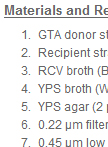Improve Research Reproducibility A Bio-protocol resource
- Protocols
- Articles and Issues
- About
- Become a Reviewer
Past Issue in 2013
Volume: 3, Issue: 2
Microbiology
Cytotoxicity Assay for Detection of Cereulide Produced by Emetic Bacillus cereus
The emetic subgroup of Bacillus cereus strains produces cereulide, a dodecadepsipeptide (1.2 kDa), which is the causative agent of food poisonings. Cereulide is synthesized by a nonribosomal peptide synthetase (NRPS), the Ces-NRPS (Ehling-Schulz et al., 2006). Cereulide is a cyclic and lipophilic potassium ionophor structurally related to the macrolide antibiotic valinomycin. Both substances act on mitochondria by depolarization and uncoupling of ATP synthesis, and this effect (mitochondrial swelling) is used to quantify cereulide in a HEp-2 cell based viability assay. In this protocol, which was modified from an assay published by Finlay et al. (1999), valinomycin is used as a reference standard for ionophor–induced cytotoxicity, because purified cereulide is not commercially available yet. This assay has been used to quantify cereulide amounts from different B. cereus mutants (Lücking et al., 2009; Frenzel et al., 2012) and to estimate cereulide levels extracted from foods (artificially) contaminated with B. cereus (Frenzel et al., 2011).
Molecular Biology
Rhodobacter capsulatus Gene Transfer Agent (RcGTA) Activity Bioassays
RcGTA, a small phage-like particle produced by Rhodobacter capsulatus, was initially identified in culture filtrates as a DNase-resistant form of DNA transfer between R. capsulatus cells. This gene transfer assay has been used to identify RcGTA-producing strains and to help determine the roles of genes thought to be responsible for RcGTA production.



